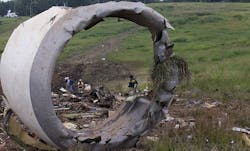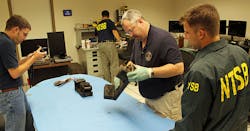NTSB: UPS Flight 1354 investigation to span months, no mechanical anomalies with aircraft found so far
BIRMINGHAM, Ala., 21 Aug. 2013. National Transportation Safety Board (NTSB) Member Robert Sumwalt provided an update on the investigative activities that have transpired since the crash of UPS Flight 1354 earlier this month in Birmingham, Ala.
The NTSB’s flight data recorder group has been working to validate and confirm the more than 400 parameters on the flight data reocrder (FDR). They have validated the initial parameters, says Sumwalt, but there is plenty more work to do.
Sumwalt revealed the following factual information related to the aviation accident of 14 Aug. 2013:
- The recorded cockpit flight control inputs and the aircraft control surface positions appear to correlate properly and appear as expected.
- The engine parameters indicate normal engine operation.
- The autopilot was engaged until the last second of recorded data.
- The flight data recording ended before the cockpit voice recording. The cockpit voice recorder (CVR) continued recording for several seconds after the flight data recorder (FDR) quit. These are two separate pieces of equipment, Sumwalt explains; one records cockpit communications, the other records aircraft data.
- Auto-throttle was engaged through the end of the recorded data.
- The recorded air speed was tracking the autoflight selected air speed of about 140 knots, which is consistent with the expected approach speed.
- Sync rate alert was heard on the cockpit voice recorder; “we also see indications on the flight data recorder that that alert was anunciated,” Sumwalt says.
“We will be correlating several pieces of data: cockpit voice recorder, flight data recorder, radar data recorded from the ATC radar system in Birmingham, and other data sources,” Sumwalt describes. “We wil pull all these sources of data together to create a composite and accurate picture of what happened to this airplane.”
Sumwalt turned attentions to the airport itself. The Federal Aviation Administration (FAA) was able to flight check the precision approach path indicator (PAPI) lights. They found the PAPI system was within 1/100th of a degree of being properly aligned. Sumwalt expects to have the full, complete flight check package by mid-week, weather permitting.
The NTSB team is obtaining airport surveillance video. “We have received one from the airport itself, and one from the Alabama National Guard. Both of these video sources appear to have captured the fire associated with the crash,” Sumwalt explains.
NTSB officials also have begun interviewing pilots and training pilots who had flown with each of the pilots involved in the crash. “We are conducting a 72-hour history, as we do for all our investigations, to try to get a picture of the flight crew’s mental and physical condition. Our investigators interviewed UPS employees and contractors who interacted with the pilots,” Sumwalt adds.
The pilots “obtained keys for the sleep rooms in Louisville. UPS has sleep rooms available for their flight crew. They signed out keys for those rooms, but we are trying to determine if they actually used those rooms.”
Over the past weekend, the team examined an exemplar UPS Airbus A300-600F aircraft. In the coming weeks, the NTSB anticipates a flight test in the aircraft to see how this approach would be flown on this particular aircraft and to learn more about UPS instrument approach procedures.
The NTSB team removed electronic equipment from the wreckage that may have non-volatile memory that may contain additional data on what this airplane was doing. Oftentimes the memory chips on some equipment still give us a lot of data, says Sumwalt. For example, the engine control module we know contains data about the operation of the engines, he says.
The NTSB maintenance group has been scouring the maintenance records of this aircraft. So far, they are reporting that all service bulletins and airworthiness directives have been complied with. So far, they have identified no mechanical anomalies with the aircraft.
Sumwalt expects the wreckage to be removed from the airport in about a week.
“This is going to be a months-long investigation,” Sumwalt predicts.
Follow Avionics Intelligence news updates on Twitter (@Avionics_Intel), LinkedIn, and Google+.
UPS Flight 1354 slideshow with NTSB images and information
UPS Flight 1354 with two crewmembers crashes on approach
UPS officials issue statement on UPS Flight 1354
NTSB investigates UPS Flight 1354 crash in Alabama
Airbus officials address crash of A300-600F operated by UPS
UPS Aircraft Fleet


